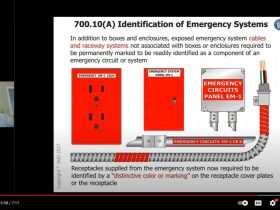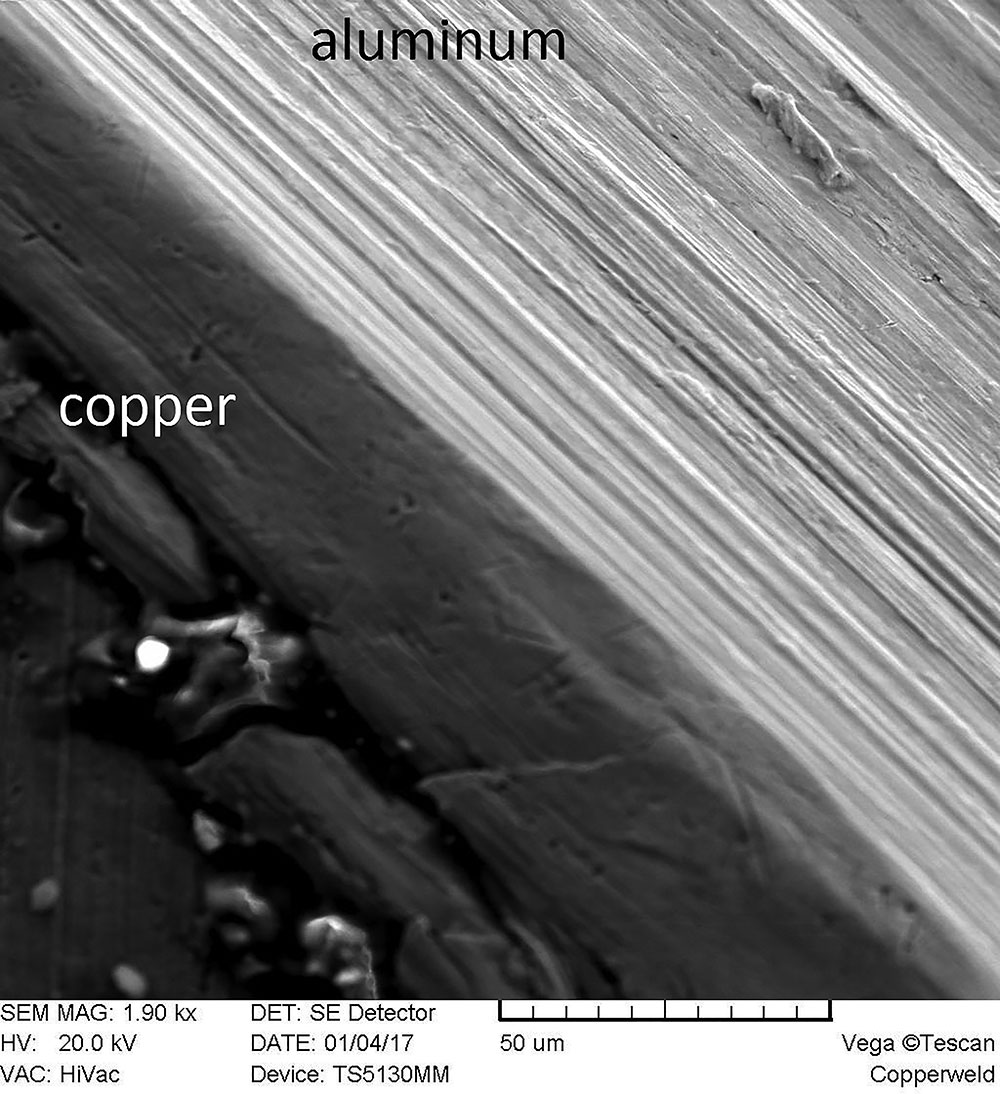Let’s say, a designer decided to utilize optical fiber cables for control of lighting circuits ortoamalgamate wiringconnecting thefire alarm field devices with wiringsupplyingthecomponentsof a security system. Issuch integration of wiring allowed by the Canadian Electrical Code?
And what about use of a nurse callpanel in a hospital as means for annunciation ofa patient room(sleeping room)smoke detector mandated by the National Building Code of Canada (NBCC)?
And how about installing conductors of communication/IT system in a raceway occupied by power circuit conductors?
And is there a problem of pulling conductors that are connected to different distribution transformers or to different generators in the same raceway andin the same enclosure.
Andlet’s try toreview whether a wiring to the corridor lighting could be installed in the same raceway as wiring to the exit signs locatedat the exit doors in this corridor.
So far the answer isa bitambiguous,asit depends on specific details of each particular installation.So, let’sevaluate the examples mentioned above in conjunction with provisions of the CE Code on this subject.
Perhaps, at the outset of this review we should emphasize the reasons for theCode provisions on thisissue. As the Code’s main objective is to providesuchelectrical installation requirements thatwouldsafeguard users against electric shock and fire hazard, then prescriptive rules of the Code on thismattermust certainly reflect thissafetyobjective. In addition to this maingoal, the objective of the CE Code is to ascertain performance of theelectrically connectedlife safety systems that are mandated by the NBCC. This additional objective is met by complying with the CE Code’svery specific criteria for installation, including separation, of conductors comprising life safety systems.
Now is the good time to look at some of our examples.
Let’s start with optical fiber cables. Section 56 of the CE Code covers installation of non-conductive, conductive and hybrid optical fiber cables. Rule 56-200 states that non-conductive optical fiber cables cannot occupy the raceway or enclosure (cabinet, panel, box, and so forth)that is occupied by conductors of electric light, power or Class 1 circuits, unless:
(a) the number and size of non-conductive optical fiber cables and other types of electrical conductors installed in the raceway or enclosure meets the applicable requirements of the Code for wiring methods of electrical conductors, and these non-conductive optical fiber cables are functionally associated with conductors comprising the electric power, lighting or Class 1 circuit, and each such circuit does not exceed 750 V; or
(b)such installation is done in an industrial establishment, where condition of maintenance and supervision ensure that only qualified personnel service all components of such installation.
Conductive optical fiber cables are allowed by the CE Code to be installed in the same raceway, box or cabinet that is used by conductors ofcommunication circuits, conductors of community antenna circuits or byconductors supplying Class 2 circuits. But under no conditions are conductive optical fiber conductors allowed to beinstalled in a raceway, box or a compartmentthat is already occupied by the conductors connected to Class 1, electric lighting or power circuits.
However, if hybrid cables are utilized, then there is no separation mandated by the CE Code between optical fibers and other conductors used for connection of electric light, power or Class 1 circuit.
In this case, a single hybrid cable could be used, provided that:
(a)voltage of the cable insulation does not exceed 750 volts and the functions between the optical fibers andelectrical conductors supplying electric light, power or Class 1 circuits are integrally associated; or
(b) functions of optical fibers and electrical conductors are associated.
If we are interested in evaluating separation requirements between conductors supplying community antenna distribution and TV network, and conductors connected to electric lighting, power or Class 1 circuits, Rule 54-400 of the CE Code covers these provisions for installations in buildings. These separation requirements range from 500 mm to 3 m, and the criteria for such minimum clearances are based on the voltage levelsat which electric lighting, power or Class 1 circuits operate. Although Rule 54-400 always requires separation between conductors connected to the community antenna distribution and conductors supplying electric light, power or Class 1 circuits, such separation may be waived if the power or Class 1 circuit conductors are placed in a raceway, box or compartment for a sole purpose of supplying power to a community antenna distribution circuit.
Section 60 of the CE Code, that covers installation of communication circuits, also mandates separation of communication conductors from conductors connected to other circuits (power, electric light, Class 1), and these clearance requirements between conductors of these different circuits, and relaxation of such clearances, are similar to the provisions of Section 56.
Conductors supplying Class 2 circuits (control, security circuits wiring, and so forth) are also required to be separated from conductors of other systems and circuits. Such separation requirements are stipulated by Rule 16-212 of the Code. This rule, however, relaxes the separation requirements between Class 2 circuit conductors and conductors of power or Class 1 circuits if these power circuit conductors are installed in the same raceway, box or compartment as class 2 conductors and the following conditions are met:
(a) Class 2 circuit conductors are insulated for the maximum voltage level of the conductors located in the raceway, box or compartment; and
(b) conductors of the power circuit are located in the enclosure (raceway, box, compartment) for the sole purpose of supplying power to the Class 2 circuit.
In addition to the specific separation requirements between conductors of particular systems or circuits (Class 2, control, communication, community antenna distribution, and so forth) and conductorsof power, electric lighting and Class 1 circuits, Rules 12-904 and 12-3030 provide generic requirements for separation between any conductors that are connected to different power sources (different transformers, generators, batteries, and so forth), where Rule 12-904 articulates such separation requirements between conductors inraceways, and Rule 12-3030 establishes such separation criteria for various conductors pulled in cabinets, boxes or compartments.
If conductors of differentpower sources are run underground, direct buried or in raceways, particular rules of Sections 16, 54, 56 or 60 establish minimumclearances requirements between these conductors.
It should be noted that CSA standard C22.3 No. 7Underground Systemsmust be also used in conjunction with the applicable CE Code rules for underground clearances.
The Code users should be aware that certain conductors, supplying such life safety equipment like fire pumps, elevators, smoke control and smoke venting fans, and so on, may not only require a physical separation from other conductors, but outright protection against exposure to fire for a period not less than 1 hour. Except for Rule 32-200(b) for fire pumps, this latter requirement is contained in the NBCC.
So, as we’re aware of the Codeseparation criteria between various conductors, we can review the questions posed at the outset of this article.
Thus, we can with full certainty decidethat a hybridcable consisting of electric lighting circuit conductors and optical fiber circuit could be installed in the same raceway or cabinet, provided that the functions of these conductors are associated by application.
And what about amalgamating wiring for a security system with the wiring for a fire alarm system?
The answer could be found in Rule 32-102(3). This rule strictly mandates that conductors of a fire alarm system must be installed completely separate and independent from all other conductors. Besides, ULC S524Standard for Installation of Fire Alarm Systemrequires that all wiring to the fire alarm devices must be electrically supervised. Therefore, wiring to the devices of a security alarm system cannot be installed in the same raceway, cabinet or box which houses a fire alarm system wiring.
However, if a fire alarm system is designed, constructed, tested and certified as an integrated “fire alarm/security” system, and the operation of the security component will not compromise operation of the NBCC mandated fire alarm system, the security wiring could be installedas a part of the fire alarm system wiring, and all relevant provisions of Section 32 of the CE Codewould have to be applied to the wiring of the security alarm system.
Another example of such potential amalgamation is use, or restriction of such use,of a nurse call panel for thepurpose of annunciation of an audible and visual signal from a smoke detector located in a sleeping room of a hospital [see Sentence 3.2.4.11(2) of the NBCC].
The nurse callpanel could be used for such purpose if the audible and visible signalfrom each smoke detector located in the sleeping room functions only as a fire alarmancillary device,(i.e., wiring to this visible and audible signal would not have to be electrically supervisedas part of the fire alarm system electrical supervision that is required by the ULC S524). This could be done only:
(a)if the wiring to such visual and audible signal at the nurse panel is installed in addition to the independent wiring to such device (which is alreadybeing installed) as an integral required component ofthe fire alarm system; or
(b) a nurse call panel that contains the NBCC required audible and visual signalis specifically designed, constructed and certified as a remote fire alarm system annunciator conforming to the standardULCS527.
And of course, the CE Code has an answer for wiring conductors of exit signs to the circuit that feeds emergency lighting in the area where such exit signs are located.
Although Rule 46-400(1) mandates a separate electrical circuit for exit signs,Subrule (2) allows connection of exit signs located in a corridor to be fed from the circuit that supplies emergency lighting in that particular corridor.
Of course, there are numerous unique cases, where the Code requirements should be analyzed in detailfor the purpose of separation of wiring. But the most important is our understanding and confidence that the Code, indeed, provides necessary guidance on this important subject.
And as usual, the respective AHJs should be consultedon the specifics of each particular installation where separation of conductors might be perceived as a design and installation challenge.














Find Us on Socials